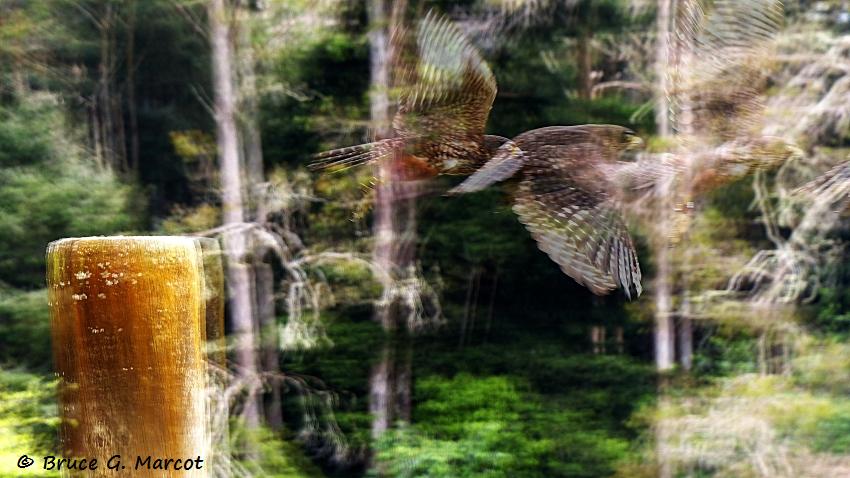
|
|
A Falcon Menagerie |
|
|
Click on images for larger versions
|
New Zealand Falcon (Falco
novaeseelandiae), Family Falconidae |
Credit & Copyright: Dr. Bruce G. Marcot
Explanation: Welcome to the New Zealand Falcon menagerie of Wingspan, New Zealand's National Bird of Prey Centre! This wonderful Birds of Prey Trust was established, as their welcoming sign notes, "for the research, captive management, rehabilitation, and public awareness of New Zealand birds of prey" ...
... particularly the spectacular and near-threatened New Zealand Falcon.
Established in 1994, Wingspan provides a superb forest setting for environmental education. The group also has been monitoring wild New Zealand Falcons in the vast Kaingaroa Forest plantations of radiata pine (Pinus radiata), in North Island's Central Plateau. Kaingaroa Forest is touted to be the largest planted forest in the southern hemisphere, extending over 140,000 hectares (356,000 acres).
Their monitoring suggests that New Zealand Falcons, unlike many other falcons and birds of prey elsewhere, seem to be sustained, and perhaps even benefited, from the large forestry plantation clear-cuts of the region, which provide nest sites, prey, and open area for hunting.
New Zealand Falcons occur on both of the main islands of the country,
but are nowhere common.The falcons use perches to scope out prey -- small mammal,
other birds, and other critters.Adult falcons can take avian prey larger than itself,
including shags (cormorants), chickens, and even pheasants!At Wingspan, New Zealand Falcons are rehabilitated if injured,
and taught to fend and feed for themselves.
Apparently, New Zealand falcons are doing well in the vast Pinus radiata plantations of New Zealand, where they are finding prey, hunting perch sites, and other resources (Pawson et al. 2010), particularly when the clear-felled sites occur as a mosaic of forest age classes across the landscape that provide nesting sites and prey (Seaton et al. 2010, 2013).
Watch, in the following series of animated sequences,
how handlers swing prey items with lures to teach the falcons to dive and pounce:
Being listed as near threatened, population trends of New Zealand Falcons
are unknown but likely declining because of overall habitat loss,
predation by invasive species, and persecution by people.
Three forms of New Zealand Falcon are recognized:
Bush, Southern, and Eastern forms, that vary by plumage, size,
habitat, and distribution.These birds are the Bush Form of North Island,
and give rise to their local name of Bush Hawk.
In this week's main image, and the one below, I photographed falcons
flying from their perch sites, using "burst mode" on my camera,
which I then later stacked together as single-image overlays.These photos clearly show the strong, direct-line flight paths.
Like some other falcons, they can stoop on their prey at high speed,
some sources citing 100 kph (60 mph).
Thanks to Wingspan's superb efforts, New Zealand Falcons continue to fly free.
Information:
Pawson, S.M., C E. Ecroyd, R. Seaton, W.B. Shaw, and E.G. Brockerhoff. 2010. New Zealand's exotic plantation forests as habitats for threatened indigenous species. New Zealand Journal of Ecology 34(3):342-355.
Seaton, R., N. Hyde, J.D. Holland, E.O. Minot, and B.P. Springett. 2008. Breeding season diet and prey selection of the New Zealand Falcon (Falco novaeseelandiae) in a plantation forest. Journal of Raptor Research 42(4):256-264.
Seaton, R., N. Hyde, J.D. Holland, E.O. Minot, and B.P. Springett. 2009. Breeding success of New Zealand Falcons (Falco novaeseelandiae) in a pine plantation. New Zealand Journal of Ecology 33(1):32-39.
Seaton, R., E. O. Minot, and J. D. Holland. 2010. Nest-site selection of New Zealand Falcons (Falco novaeseelandiae) in plantation forests and the implications of this to forestry management. Emu 110(4):316-323.
Seaton, R., E. O. Minot, and J. D. Holland. 2013. Home range and habitat use of New Zealand Falcons (Falco novaeseelandiae) in an exotic plantation forest during the breeding season. Journal of Raptor Research 47(3):223-233.Acknowledgments:
My thanks to Noel Hyde, Trustee, Wingspan National Bird of Prey Centre, Rotorua, New Zealand, for accommodating my visit, and for all the fine work that he and all the Wingspan staff do for birds of prey of New Zealand. My thanks also to Steve Pawson of Scion, New Zealand for hosting my visit and bringing me to Wingspan.
Next week's picture:
The Deceptive Paintbrush
< Previous ... | Archive |
Index |
Location | Search | About EPOW | ... Next >
|
|
Author & Webmaster: Dr.
Bruce G. Marcot
Disclaimers and Legal
Statements
Original material on Ecology Picture of the Week ©
Bruce G. Marcot
Member Theme of The Plexus